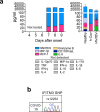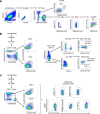Breadth of concomitant immune responses prior to patient recovery: a case report of non-severe COVID-19
- PMID: 32284614
- PMCID: PMC7095036
- DOI: 10.1038/s41591-020-0819-2
Breadth of concomitant immune responses prior to patient recovery: a case report of non-severe COVID-19
Conflict of interest statement
S.R.L.’s institution received funding for investigator-initiated grants from Gilead Sciences, Merck, Viiv Healthcare and Leidos; and honoraria for advisory boards and educational activities (Gilead Sciences, Merck, Viiv Healthcare and Abbvie).
Figures




Similar articles
-
Patterns of IgG and IgM antibody response in COVID-19 patients.Emerg Microbes Infect. 2020 Dec;9(1):1269-1274. doi: 10.1080/22221751.2020.1773324. Emerg Microbes Infect. 2020. PMID: 32515684 Free PMC article. No abstract available.
-
The importance of cell-mediated immunity in COVID-19 - An opinion.Med Hypotheses. 2020 Oct;143:110152. doi: 10.1016/j.mehy.2020.110152. Epub 2020 Jul 31. Med Hypotheses. 2020. PMID: 32759017 Free PMC article. No abstract available.
-
COVID-19 pneumonia: CD8+ T and NK cells are decreased in number but compensatory increased in cytotoxic potential.Clin Immunol. 2020 Sep;218:108516. doi: 10.1016/j.clim.2020.108516. Epub 2020 Jun 20. Clin Immunol. 2020. PMID: 32574709 Free PMC article.
-
Immune Parameters and COVID-19 Infection - Associations With Clinical Severity and Disease Prognosis.Front Cell Infect Microbiol. 2020 Jun 30;10:364. doi: 10.3389/fcimb.2020.00364. eCollection 2020. Front Cell Infect Microbiol. 2020. PMID: 32695683 Free PMC article. Review.
-
On the genetics and immunopathogenesis of COVID-19.Clin Immunol. 2020 Nov;220:108591. doi: 10.1016/j.clim.2020.108591. Epub 2020 Sep 10. Clin Immunol. 2020. PMID: 32920210 Free PMC article. Review.
Cited by
-
The molecular mechanisms of CD8+ T cell responses to SARS-CoV-2 infection mediated by TCR-pMHC interactions.Front Immunol. 2024 Oct 10;15:1468456. doi: 10.3389/fimmu.2024.1468456. eCollection 2024. Front Immunol. 2024. PMID: 39450171 Free PMC article. Review.
-
Covid-19-induced pulmonary hypertension in children, and the use of phosphodiesterase-5 inhibitors.F1000Res. 2022 Sep 12;10:792. doi: 10.12688/f1000research.53966.2. eCollection 2021. F1000Res. 2022. PMID: 39228925 Free PMC article. Review.
-
COVID-19 prevention behaviors and dietary habits among undergraduate students: A health belief model approach.PLoS One. 2024 Aug 29;19(8):e0309623. doi: 10.1371/journal.pone.0309623. eCollection 2024. PLoS One. 2024. PMID: 39208156 Free PMC article.
-
A novel metric-based approach of scoring early host immune response from oro-nasopharyngeal swabs predicts COVID-19 outcome.Sci Rep. 2024 Aug 22;14(1):19510. doi: 10.1038/s41598-024-70161-8. Sci Rep. 2024. PMID: 39174586 Free PMC article.
-
Cellular immune response to SARS-CoV-2 and clinical presentation in individuals exposed to endemic malaria.Cell Rep. 2024 Aug 27;43(8):114533. doi: 10.1016/j.celrep.2024.114533. Epub 2024 Jul 24. Cell Rep. 2024. PMID: 39052480 Free PMC article.
References
Publication types
MeSH terms
Substances
Grants and funding
LinkOut - more resources
Full Text Sources
Other Literature Sources

